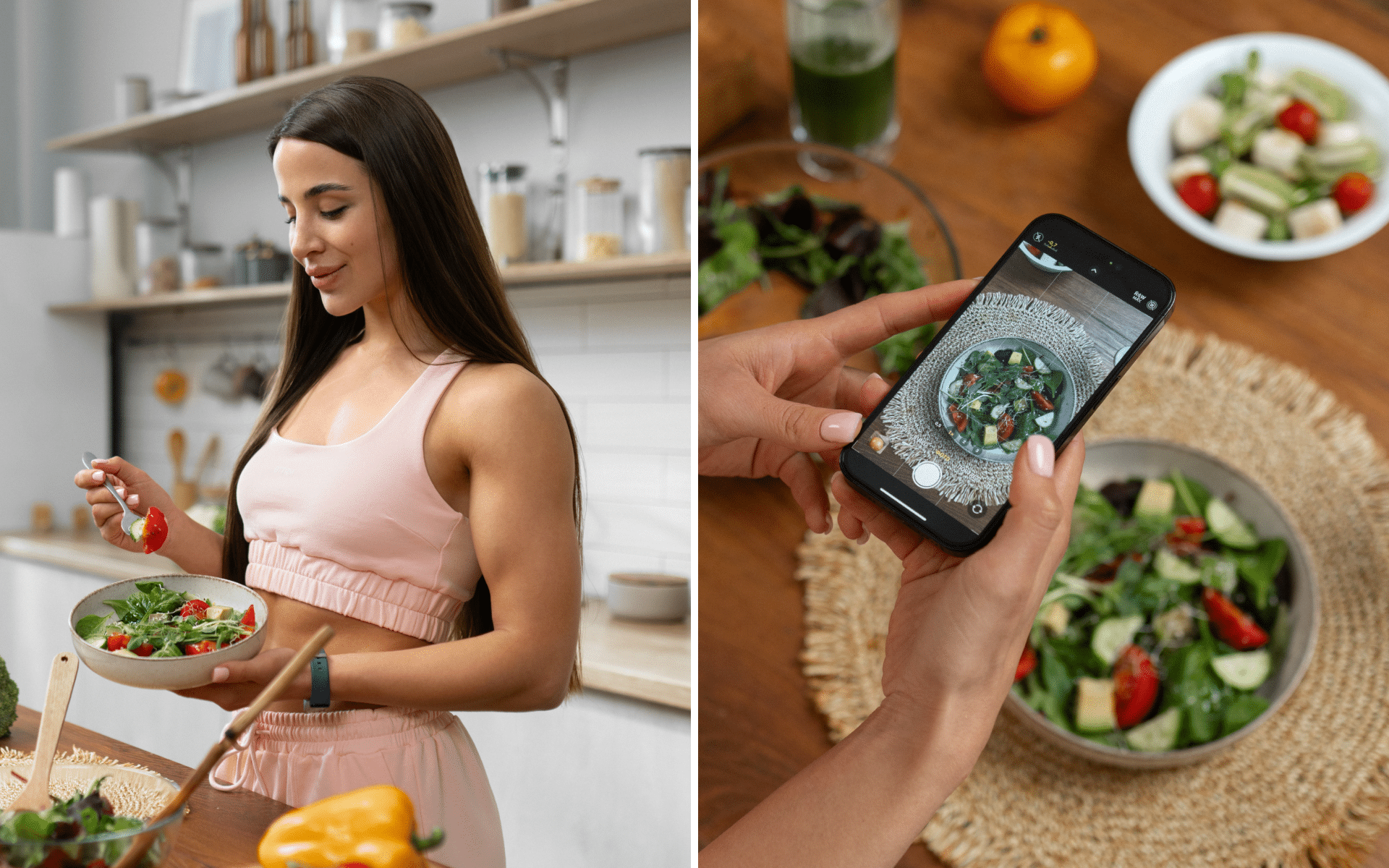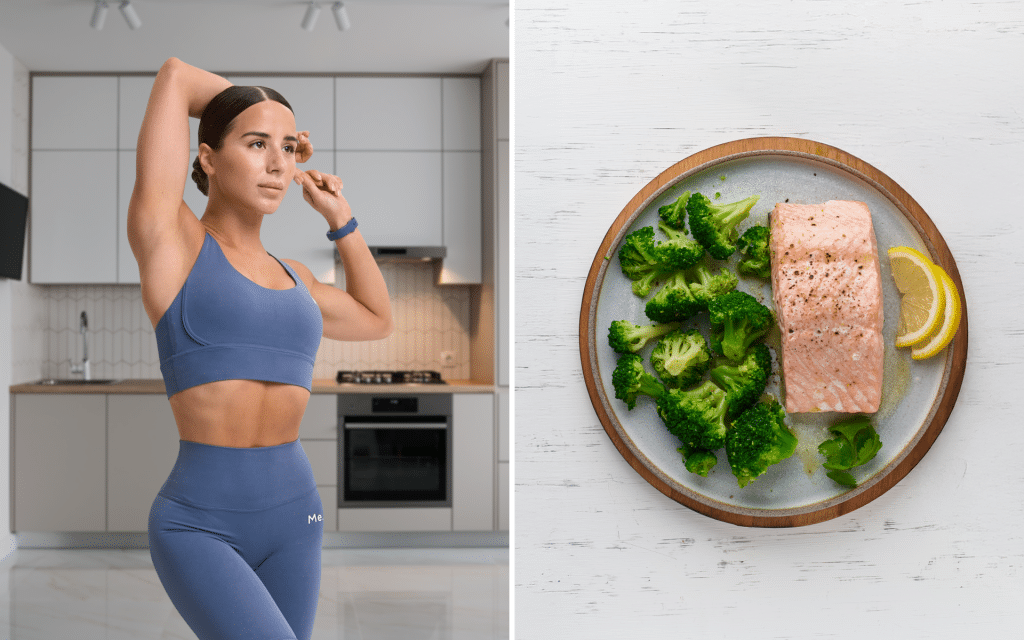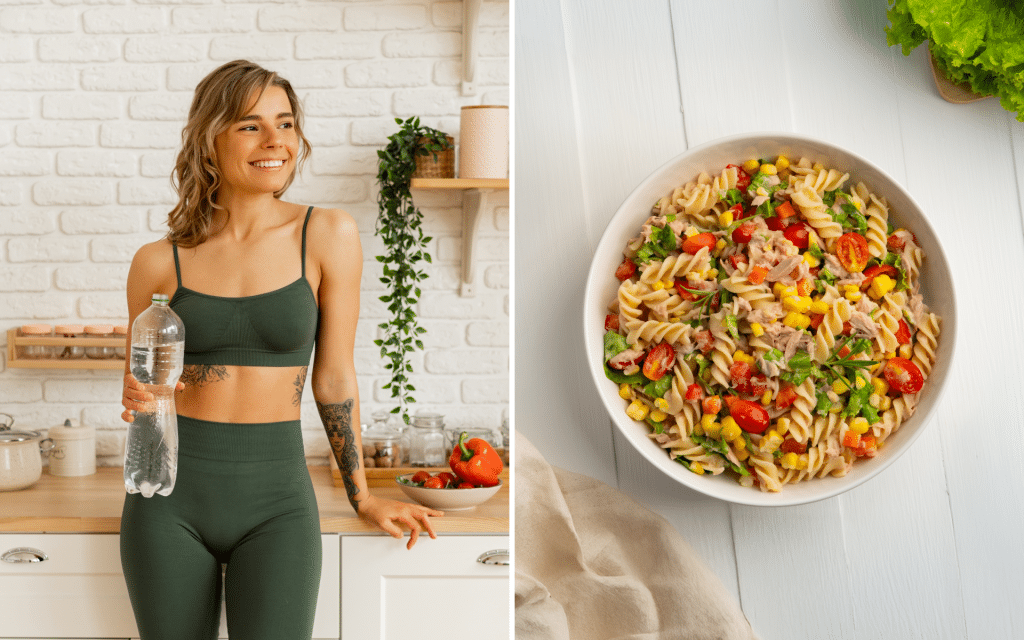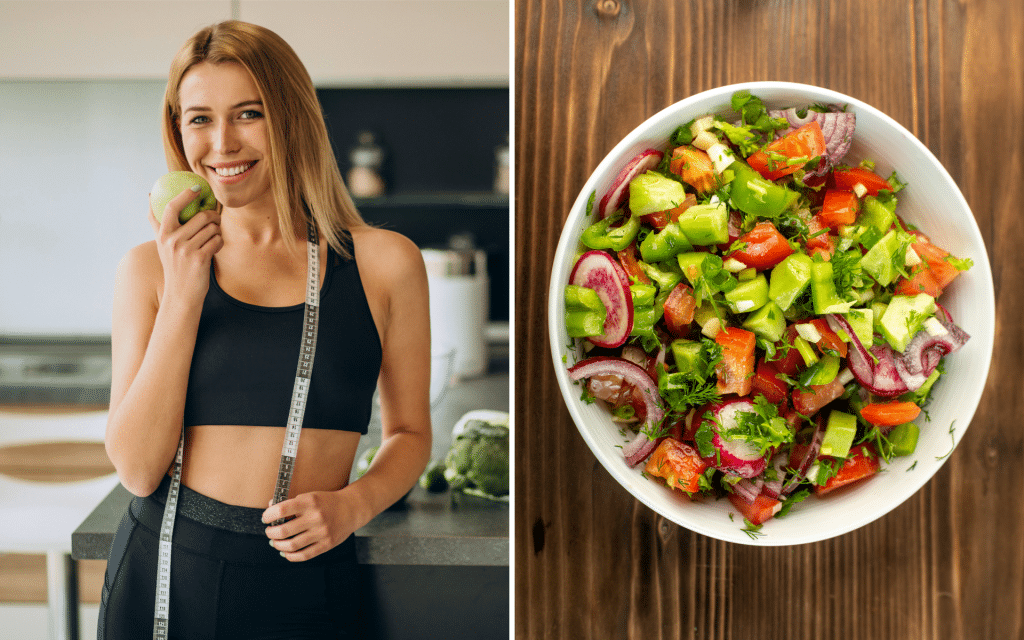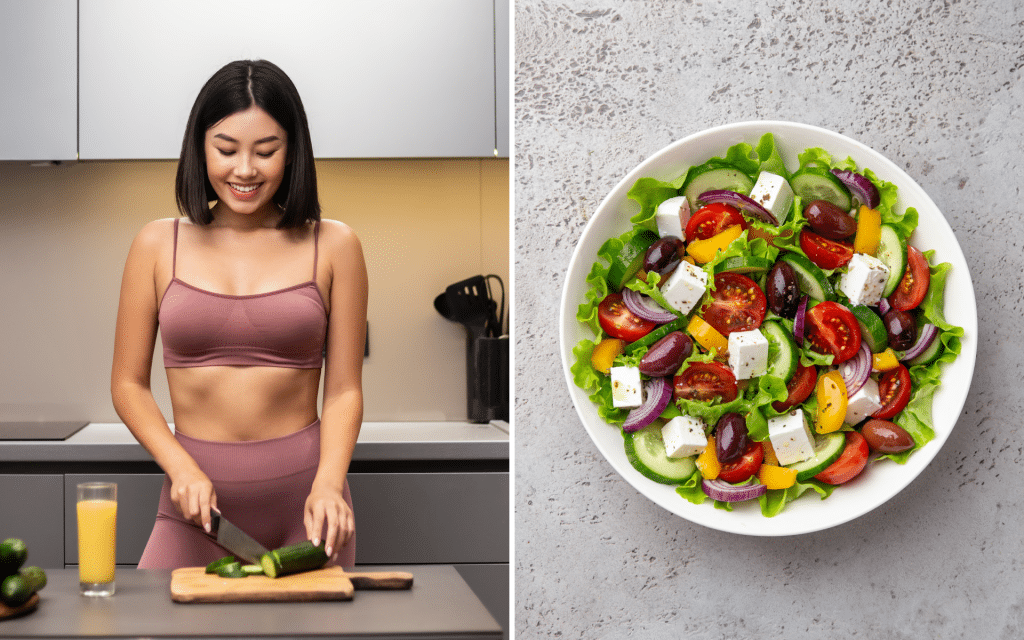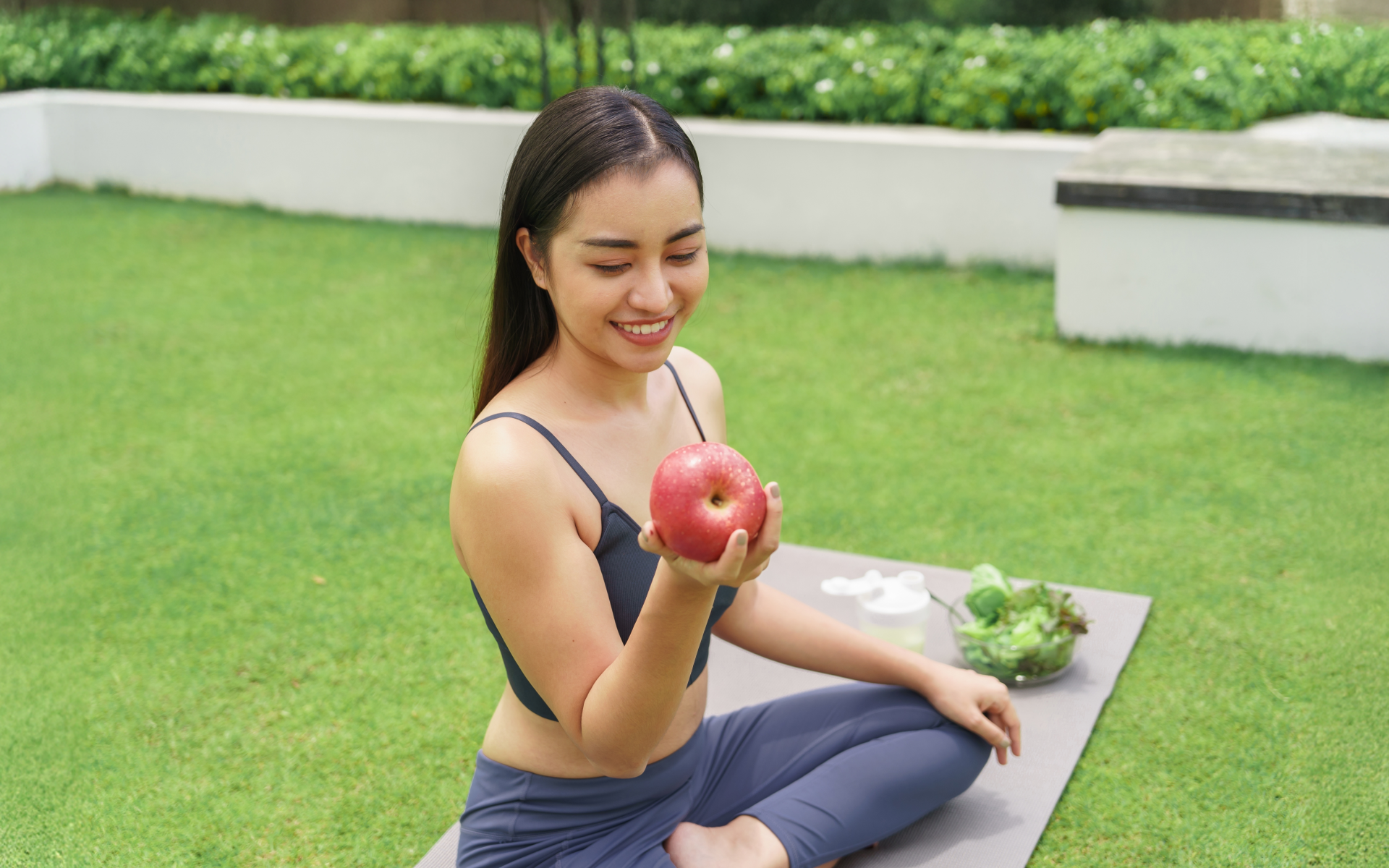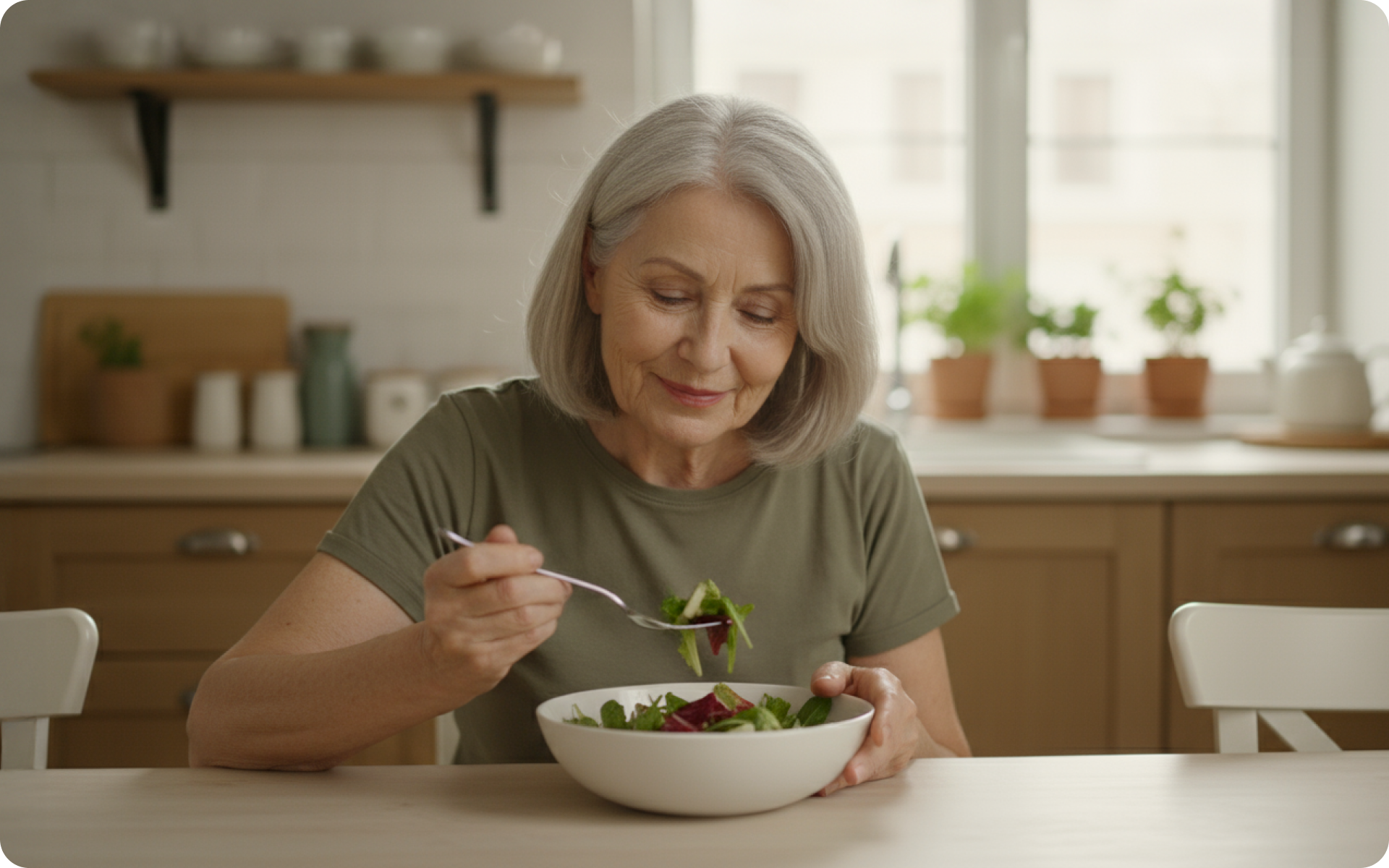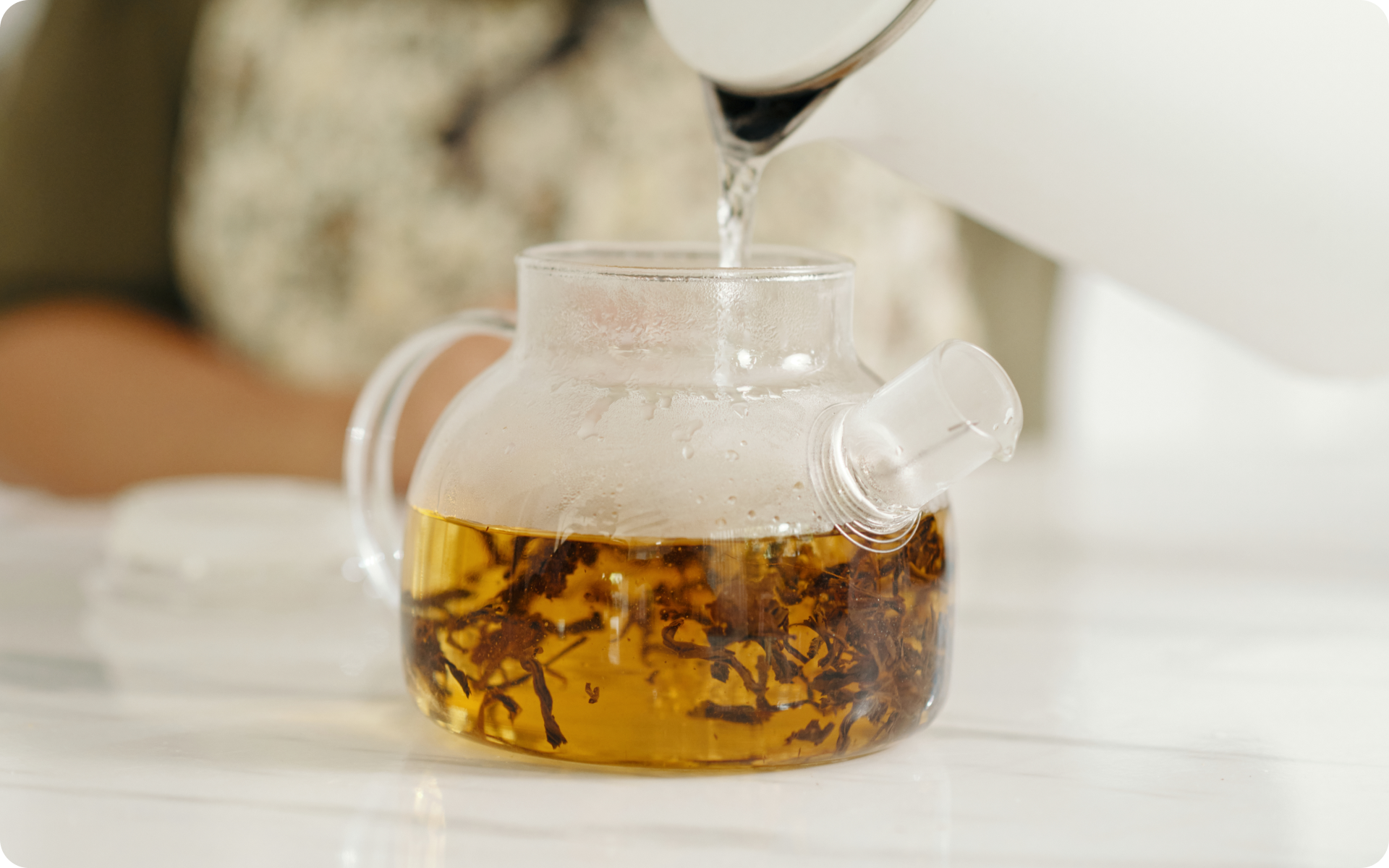Our hectic lives sometimes lead us to compromise some aspects of our health.
You may not have enough time to eat healthily or exercise daily.
This pattern can build over time, negatively impacting physical and mental well-being.
More and more research supports the importance of mindful food choices (1).
Combine it with a solid workout routine, and you can experience a whole new level of self-confidence (2). If you want to turn over a new leaf and create a better tomorrow, now is the time to take action!
Start with a clean eating challenge.
You can add more lifestyle tweaks to the mix later.
Practices that start today can eventually lead to lifelong habits.
This article discusses these clean-eating challenge topics:
- General rules
- Common mistakes
- How to create a clean eating routine that reaps the most rewards
What Is A Clean Eating Challenge?
A clean eating challenge is a structured program to help you make healthier food choices.
There isn’t an accepted definition of “clean” eating.
It typically focuses on more nutrient-dense and minimally processed foods.
Some clean eaters prefer fresh or organic fruits and vegetables and choose foods with simple, short ingredient lists.
The duration depends on your choice.
You may start with the basic 7-day challenge or extend it up to 30 days.
Start this practice as long as your definition of clean eating is:
- Balancing and not restricting
- Meeting all your nutrient requirements
- Containing a variety of foods from all food groups
These programs aim to help people eat “clean.”
Some clean eating goals involve resetting a healthy relationship with food, enhancing digestion, and improving energy levels (3).
A study in the Nutrients journal examined how teens and young adults in the U.S. view clean eating (4).
Of those surveyed, 70.8% saw it as healthy, 6% as unhealthy, and 18% believed it had both good and bad sides, potentially leading to disordered eating.
There are several options for these challenges. You can find clean eating challenges for beginners and even specialized clean eating challenges for weight loss.
Many clean eating challenges include these features to make the journey easier and more enjoyable:
- Recipes
- Meal plans
- Community support
You can also set your own goals for the challenge according to your individual needs and preferences.
So, whether you are looking to jumpstart a healthy lifestyle, feel better, or explore a cleaner way of eating, a clean eating challenge offers a potential structure to help you succeed.
Can You Lose Weight Just By Clean Eating?
Clean eating may have a different meaning when you add unrealistic expectations.
A survey of teenagers and young adults discovered that 71% defined clean eating as a healthy and positive approach (4).
However, a small percentage of people viewed it as unhealthy due to its potentially highly restrictive nature. Due to its strong association with health, clean eating was favored according to another survey of college students, although researchers have linked this diet with emotional distress and functional impairment (5).
Typically, people start a clean eating challenge for weight loss.
These plans range between 1200 and 1800 calories, the low end of many people’s required calories. Any type of diet should work for weight loss as long as it results in a calorie deficit (i.e., eating fewer calories than you expend), although the healthfulness of individual diets is a separate consideration.
Some plans may include supplements and questionable medical treatments, which experts have warned against.
Therefore, everyone must consult a registered dietitian before starting any clean-eating program.
Regarding weight loss, consuming fewer ultra-processed foods and added sugars can help your body become leaner. These foods are high in calories, and avoiding them reduces calorie intake.
If you wish to free yourself from all the extra pounds that have been weighing you down for way too long, start using the BetterMe: Health Coaching app and overhaul your entire life!
The following are some clean eating tips if you want to shed the extra pounds:
- Eat at home more often: Get creative in the kitchen with all the natural ingredients and seasonal vegetables.
- Shop the perimeter of grocery stores: This area usually contains produce and other fresh foods. Some items in the middle are also healthy, like dried or canned beans, frozen fruits and vegetables, and whole grains. However, to avoid temptation, minimize time in the snack and candy aisles.
- Stop eating “diet food” items: Stuff like diet soda and low-fat dressings usually contain artificial sweeteners and preservatives, which some clean eaters avoid (6). Sometimes, manufacturers replace fat with added sugars to lower the calorie content while making the food or condiment taste good.
- Kick-off refined carbs – Refined grains like white bread, pasta, or white rice won’t fill you up. They lack the fiber that whole grains are naturally rich in (7). Fiber helps you feel full for longer, which can reduce snacking or overeating.
- Choose nutrient-rich foods. These foods are generally lower in calories but have a high nutrient profile. Eggs, broccoli, berries, and seeds are delicious ways to eat clean.
- Check the labels: Reading nutrition labels and a list of ingredients helps you determine all the contents that make up your food. Toss off those with a lot of added sugar and unhealthy fats.
Preparing meals is one of the biggest hurdles in a clean-eating challenge. Lack of time and will is one of the main reasons most people snap out of a clean-eating challenge.
But when you incorporate these tips into your lifestyle, they become habits you get used to—without much effort!
Read more: The Navy Diet Explained: Benefits, Risks, And Results
Does Clean Eating Reduce Belly Fat?
A clean eating challenge meal plan emphasizes nutrient-dense, minimally processed foods over packaged, ultra-processed foods. A balanced meal plan gives your body all it needs to stay fresh and function optimally.
To make sure that you lose fat around the belly area, you should focus on the following elements of clean eating:
- Eat More Fatty Fish
Fatty fish can be beneficial for health and weight loss.
Examples of fatty fish rich in protein and omega-3s:
- Salmon
- Herring
- Sardines
They support brain health, keep your heart healthy, and may help you live longer.
Some studies also suggest that fatty fish help reduce body fat (8). Make fatty fish one of your main proteins, and aim for a few servings weekly.
- Consume Probiotic-Rich Foods
Scientists believe that the gut microbiome may influence several aspects of health, including overweight and obesity. Some studies have suggested that probiotic supplementation may help with weight loss.
We need more research to determine which specific strains and dosages are effective.
However, consuming more probiotic-rich foods, like yogurt and fermented vegetables, can be beneficial. These foods are usually nutrient-dense, healthy, and have the bonus of being rich in friendly bacteria.
- Take More Soluble Fiber
Fiber, especially soluble fiber, is key to overall health and weight loss.
It absorbs water and slows digestion, helping you feel full longer. This fiber can help you feel satisfied with smaller portions and fewer calories.
Foods rich in soluble fiber include:
- Whole grains
- Pulses
- Seeds
- Nuts
- Fruits
- Vegetables
Foods with the highest fiber content include:
- Oats
- Avocados
- Chia seeds
- Black beans
- Sweet potatoes
- Brussels sprouts
Reasons why BetterMe is a safe bet: a wide range of calorie-blasting workouts, finger-licking recipes, 24/7 support, challenges that’ll keep you on your best game, and that just scratches the surface! Start using our app and watch the magic happen.
- Lower Your Stress Levels
Stress plays a significant role in belly fat. High stress raises cortisol levels, which can increase appetite and cause more fat to be stored in your abdomen (11).
Lowering stress can help reduce its impact on belly fat. Try relaxation techniques or other stress management practices.
- Consume More Proteins
Eating more protein can help you feel full and reduce your appetite. High-protein diets can help you lose weight and preserve muscle mass (12).
Fatty fish is an excellent source of high-quality protein. It’s packed with nutrients in every bite. But you don’t have to rely only on fish or meat. Eggs, dairy, and legumes are also excellent protein options.
Given all these rules, clean eating for beginners is tough.
Keeping yourself away from your favorite food items could take a toll on your mental health.
If you are in this boat, start slowly and go at your own pace. See every individual healthy choice as a win.. Look for recipes to make your clean eating challenge fun and fulfilling!
What Are The Rules For The Clean Eating Diet?
Clean eating can take a different meaning when you attach unrealistic expectations to it.
Learn the fundamentals first. For instance, understand the concept of processed vs. ultra-processed foods to make better choices.
Below, I have listed some rules that dominate most clean eating challenges:
- Eat foods closer to their natural state, like fruits, vegetables, whole grains, nuts, and seeds.
- Frozen, canned, and dried options are okay as long as they don’t contain a lot of added sugar, sodium, or unhealthy fats.
- Avoid packaged foods with a lot of added sugars, artificial flavors, and long ingredient lists.
- Reduce intake of refined sugars and excessive salt. Use natural sweeteners or herbs for flavor.
- Drink plenty of water and avoid sugary beverages.
- Include healthy proteins like fish, eggs, legumes, poultry, and plant-based options.
- Choose fats and oils from avocados, nuts, seeds, and olive oil. Limit saturated fats.
- Control ingredients and avoid hidden additives by preparing meals at home.
- Occasional indulgences are okay. Aim for balance, not perfection.
If you want to eat cleaner, take baby steps. Slowly add whole foods to your diet, but don’t do it suddenly.
Check out how to pursue a clean eating challenge for beginners, and seek professional consultation for guidance.
How To Start Clean Eating?
As mentioned earlier, you can take baby steps when eating clean.
Here are a few things that could help you get started:
- Understand the rules of clean eating.
- Replace ultra-processed foods with less processed options.
- Create a weekly meal plan with clean eating challenge recipes that you can use beyond the 28 days to avoid impulsive, unhealthy choices.
- Experiment with herbs and spices to add flavor naturally.
- Build a routine that works for you and stick with it. Over time, clean eating will become a habit.
Clean eating lets you enjoy the foods you love by finding healthier versions. You can still have treats like ice cream and red wine if made with natural ingredients and enjoyed in moderation. Clean eating isn’t a strict diet. It is a lifestyle focused on eating the purest, most natural food.
You may also want to include exercise in your clean eating challenge. Multiple studies have discovered that exercise combined with a healthy diet can have many health benefits. A 2012 University of Michigan study found that women in their 70s lived longer when exercising and regularly eating fruits and vegetables (15).
Another study published in the International Journal of Obesity found that an exercise regime may also inspire you to eat healthily (16). Engaging in a 15-week exercise program was linked to less interest in typical Western diet foods like red meat, fried foods, and snacks. On the other hand, the exercise program seemed to motivate participants to make healthier food choices.
How Long Does Clean Eating Take To Work?
When you participate in a clean eating challenge, you may anticipate when the results start showing up. So, note that you may witness some results in the first few days, all the while progressing towards bigger changes as time passes by.
The following table summarizes what may happen when you start a clean eating challenge (regardless of the timeframe):
| Area of Improvement | Timeframe for Results |
|---|---|
| Energy Levels | A few days – as your body starts getting more nutrients from whole foods |
| Digestive Health | 1–2 weeks – improved digestion and reduced bloating due to increased fiber intake |
| Weight Loss | 2–4 weeks – depending on calorie intake, activity level, and metabolism. This could also take longer, depending on individual factors |
| Skin Health | A few weeks to months – clearer or more hydrated skin as your body adjusts to healthier eating habits |
| Overall Health | Several months – noticeable blood sugar, cholesterol, or long-term health changes |
Remember that consistency is key when you want things to turn out, as shown in the table. When you start munching on more nutritious foods, your body may respond to them differently.
You might feel less bloated in a few weeks as your body gets used to the increased fiber (18).
You may see a slight weight loss and feel more energetic from eating steady, long-lasting energy sources. After a few months, you might notice more weight loss.
If you’re losing about 1-2 pounds per week, that is considered a safe and sustainable pace.
Read more: Plant-Based Diet Meals: Simple Examples, Benefits, Potential Side Effects & More
What Is The 28 Day Clean Eating Challenge?
Many wonder about this diet and ask, “How does the 28 day clean eating challenge work?
This clean eating challenge works by helping you transition to healthier eating habits.
Experts designed clean eating challenges to help people develop healthy eating habits.
The challenges balance the 3 principles of:
- Balance
- Mindful eating
- Nutrient density
Each day/week of the challenge has a different focus.
Check out this sample 28-day clean eating challenge that could give you an insight into what it should look like:
Week 1: Clean The Basics
- Eat: Focus on whole, minimally processed foods—fruits, vegetables, whole grains, lean proteins, healthy fats.
- Avoid: Ultra-processed foods, sugary drinks, and refined grains.
- Exercise: 30 minutes of light cardio (e.g., walking, cycling) 4 times a week.
Week 2: Build Healthy Habits
- Eat: Increase plant-based foods, and add more fiber (beans, lentils, veggies).
- Avoid: Artificial additives and preservatives.
- Exercise: Add strength training (bodyweight exercises like squats and lunges) 2 times a week, plus cardio.
Week 3: Focus On Balance
- Eat: Continue with whole foods, including lean protein, with each meal (chicken, fish, tofu).
- Avoid: Excess sugar and salty snacks.
- Exercise: Increase cardio intensity (30 minutes, 5 times a week) and add core workouts.
Week 4: Refine & Sustain
- Eat: Focus on portion control and balance with treats (if you consume any).
- Avoid: Overeating (even with clean foods), Ultra-processed foods, or cheat meals.
- Exercise: 30-45 minutes of mixed exercise (cardio + strength) 4-5 times weekly.
By the end of 28 days, you may feel like you are a better version of yourself.
It doesn’t mean you must switch to unhealthy eating patterns on the 29th day.
Although you can have your favorite foods again, practice moderation.
Keep your clean eating meal plan in mind, and consume more foods that abide by its principles.
This weekly progress is in line with the plan discussed earlier.
The results may differ according to the number of days and caloric consumption.
Ideally, by the end of 28 days, you will likely see improvements in your energy, weight, and digestion. Just don’t cross the boundaries you set for yourself in these 28 days.
The most effective way to burn stomach fat is through a healthy diet, regular exercise, and maintaining a calorie deficit. Focus on a balanced diet, strength training, and aerobic activities like running or cycling for optimal results. Chia seeds alone won’t reduce tummy fat, but their high fiber content can support digestion and help you feel full. This may aid in weight management combined with a healthy diet and exercise. Yes, cheese can be included in a clean eating challenge if consumed in moderation. It should be chosen in its natural, minimally processed form, like fresh mozzarella, feta, or cottage cheese. Just avoid processed cheese products. Yes, yogurt can be part of clean eating. But, ideally, it should be plain, unsweetened, and free from artificial additives. Opt for Greek or natural yogurt for higher protein content. You can add your own flavorings, like fruit, honey, and nuts.Frequently Asked Questions
What burns the most stomach fat?
Do chia seeds reduce tummy?
Is cheese allowed on clean eating diet?
Is yogurt clean eating?
The Bottom Line
Clean eating is a lifestyle. Many times, when people start a new diet, they restrict way too much. Such changes aren’t sustainable and may negatively impact the future.
On the other hand, joining a clean eating challenge teaches a different approach.
One has to embed it into their lifestyle without straining themselves too much.
Start your clean eating challenge by aiming for clean meals 80% of the time.
Save the other 20% for that slice of cheesecake or your mom’s savory lasagna.
If you slip up, don’t stress. It’s all part of the process—just dust yourself off and keep going!
You got this!
DISCLAIMER:
This article is intended for general informational purposes only and does not serve to address individual circumstances. It is not a substitute for professional advice or help and should not be relied on for making any kind of decision-making. Any action taken as a direct or indirect result of the information in this article is entirely at your own risk and is your sole responsibility.
BetterMe, its content staff, and its medical advisors accept no responsibility for inaccuracies, errors, misstatements, inconsistencies, or omissions and specifically disclaim any liability, loss or risk, personal, professional or otherwise, which may be incurred as a consequence, directly or indirectly, of the use and/or application of any content.
You should always seek the advice of your physician or other qualified health provider with any questions you may have regarding a medical condition or your specific situation. Never disregard professional medical advice or delay seeking it because of BetterMe content. If you suspect or think you may have a medical emergency, call your doctor.
SOURCES:
- Mindful Eating (2020, nutritionsource.hsph.harvard.edu)
- Physical activity and self-esteem: testing direct and indirect relationships associated with psychological and physical mechanisms (2016, pmc.ncbi.nlm.nih.gov)
- 2024 IFIC Food & Health SURVEY (2024, foodinsight.org)
- “It’s Healthy Because It’s Natural.” Perceptions of “Clean” Eating among U.S. Adolescents and Emerging Adults (2020, pmc.ncbi.nlm.nih.gov)
- Is #cleaneating a healthy or harmful dietary strategy? Perceptions of clean eating and associations with disordered eating among young adults (2019, jeatdisord.biomedcentral.com)
- Artificially Sweetened Beverages Beyond the Metabolic Risks: A Systematic Review of the Literature (2023, pmc.ncbi.nlm.nih.gov)
- The Hidden Dangers of Fast and Processed Food (2018, pmc.ncbi.nlm.nih.gov)
- Fatty Fish (2013, sciencedirect.com)
- Shaping the stress response: interplay of palatable food choices, glucocorticoids, insulin and abdominal obesity (2008, pubmed.ncbi.nlm.nih.gov)
- Clinical Evidence and Mechanisms of High-Protein Diet-Induced Weight Loss (2020, pmc.ncbi.nlm.nih.gov)
- Fruit and Vegetable Intake, Physical Activity, and Mortality in Older Community-Dwelling Women (2012, agsjournals.onlinelibrary.wiley.com)
- The influence of 15-week exercise training on dietary patterns among young adults (2019, nature.com)
- Dietary fiber: Essential for a healthy diet (n.d., mayoclinic.org)
